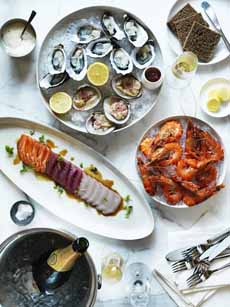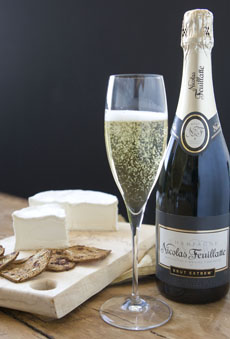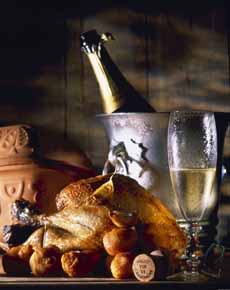|

[1] Champagne pairs well with any fish or seafood, including sushi and sashimi (photo courtesy Latte Luxury News).

[2] Enjoy your favorite cheeses with Champagne (photo courtesy Champagne Bureau).

[3] Drink Champagne with poultry or pork (photo courtesy Champagne Bureau).
|
|
Why wait for New Year’s Eve to crack open the bubbly? October 19th is World Champagne Day.
Held the third Friday in October, there’s time to pick up a bottle for a pre-dinner cocktail and/or sparkling wine with dinner.
Raise a glass to the quintessential wine of celebrations, good cheer and toasting everywhere.
While there are great sparkling wines from around the world, Champagne is distinctive with its chalky, toasty, yeasty/biscuity flavors. These flavors come from layers of chalk under the region’s soil, set down by the glaciers, that have created a unique terroir*.
Younger Champagnes can be floral, fruity and spicy. As they age they take on honey, nutty, toffee and other flavor nuances. After 20 years or so, mature Champagnes develop nuances of mushroom flavor.
Check out this image of the flavors and aromas as the wine ages.
See the footnote† below for the seven grapes that can be used to make Champagne.
TOP CHAMPAGNE COCKTAILS
Make cocktails with nonvintage Champagnes, and choose bubbly on the lower end (although with authentic Champagne, this means close to $30).
That’s because in a cocktail, the subtle, complex nuances of the best Champagnes can be masked up by the mixers.
Here are some popular Champagne cocktails. When you don’t have champagne, any sparkling wine works.
Barbotage (Champagne, Cognac, Grand Marnier)
Bellini (if peaches aren’t in season, you need peach purée)
Black Velvet (Champagne and stout)
Champagne Cocktail (Champagne, bitters, sugar cube)
Champagne Punch (Champagne, brandy, cointreau, club soda)
French 75
Kir Royale
Mimosa
Sgroppino (made with prosecco, vodka and lemon sorbet, but it’s easy to substitute Champagne)
Another of our favorites is the simple but elegant St. Germain Cocktail: an inch or so of St. Germain elderflower liqueur topped off with Champagne.
CHAMPAGNE FUN
Champagne Gelatin Shots
Champagne Gummy Bears
Champagne Ice Pops
Champagne Sorbet
FAVORITE FOOD PAIRINGS
Here are our favorite pairings with Champagne. Drink the Champagne straight to enjoy the crisp acidity and flavors that come from the Chardonnay and/or Pinot Noir grapes†.
|
|
Caviar: You don’t need the deep pockets for sturgeon caviar. Salmon caviar, trout caviar or whitefish caviar are just dandy (check out the types of affordable caviar).
Cheese: Double- and triple-creme cheeses are sumptuous with Champagne. Brie and Camembert are typically double-crèmes (here’s the difference between Brie and Camembert); triple-crèmes like Brillat-Savarin, Explorateur and St. André are even richer and creamier. But since Champagne is white wine, it goes with just about any cheese.
Dessert: Champagne pairs well with cheesecake, but for sweeter desserts get a sweeter Champagne. These are labeled sec or demi-sec. While sec is the French word for dry, an anomaly in Champagne is that brut indicates dry and sec indicates sweet.
Pâte or Mousse De Foie Gras: Made from duck or goose liver, these are classic pairings with Champagne. Chicken mousse pâte is less expensive and equally delicious.
Roast Poultry Or Pork: Champagne can transform a simple roast chicken into a feast.
Seafood: Any fish or seafood can be paired with Champagne, including sushi and sashimi and a classic plat de fruits de mer—clams, lobster, mussels, oysters and shrimp.
Smoked Fish: Smoked salmon or other smoked fish is another time-honored marriage with Champagne. Serve it any way you like, including canapés or spreads like smoked salmon rillettes). Don’t forget bagels, lox and cream cheese!
Stuffed Mushrooms: Champagne can have mushroomy flavors, especially as it ages Stuffed mushrooms go nicely—even if the flavor is citrussy or toasty instead of mushroomy.
Beyond European Cuisine
Champagne pairs well with foods of the Pacific Rim.
Asian: Since so any dishes in Chinese, Thai and Vietnamese cuisine are made with fish, vegetables and poultry, white wines including Champagne.
Indian: Enjoy bubbly with Indian cuisine: Chicken Tikka Masala and other poultry, vegetable or fish favorites.
We’ll leave you now to go pop a cork or two.
________________
*ABOUT TERROIR: The same rootstock that is grown in different locations produces different flavors; for example, depending on where it is grown, Sauvignon Blanc can have grass or grapefruit notes—or neither. Terroir, pronounced tur-WAH, is a French agricultural term referring to the unique set of environmental factors in a specific habitat that affect a crop’s qualities. It includes climate, elevation, proximity to a body of water, slant of the land, soil type and amount of sun. These environmental characteristics gives the wine its character. Terroir is the basis of the French A.O.C. (appellation d’origine contrôlée) system.
†THE 7 CHAMPAGNE GRAPES PERMITTED BY LAW: The two main grapes of Champagne are Chardonnay and Pinot Noir. Blanc de Blanc Champagnes are 100% Chardonnay and are lighter with more acidic raciness. Blanc de Noir Champagnes are all Pinot Noir, which has elegance, perfume and body. Most Champagnes are blends of the two.
The wines can also contain five other grapes to bring out other characteristics: Fromenteau (fruitiness), Petite Arbanne (rusticity), Petite Meslier (green flavors and high acidity), Pinot Blanc (floral and honey aroma, rich body) and Pinot Meunier (richness and fruit). These blending grapes are used in smaller percentages to balance out the features of the year’s harvest (e.g., over-ripeness, under-ripeness, light body) of the two main grapes. One or more, or none, may be used by the winemaker in any particular harvest. Here’s more about them.
|


